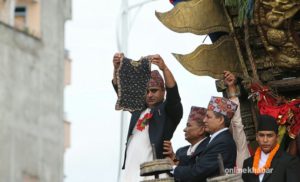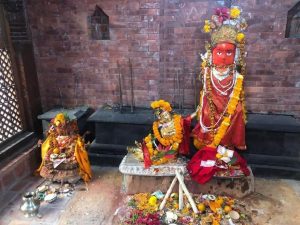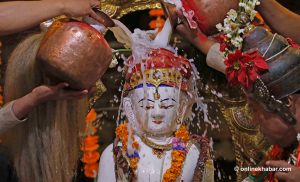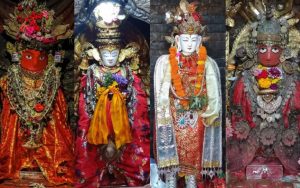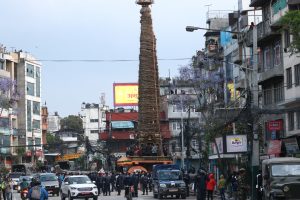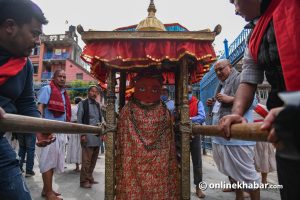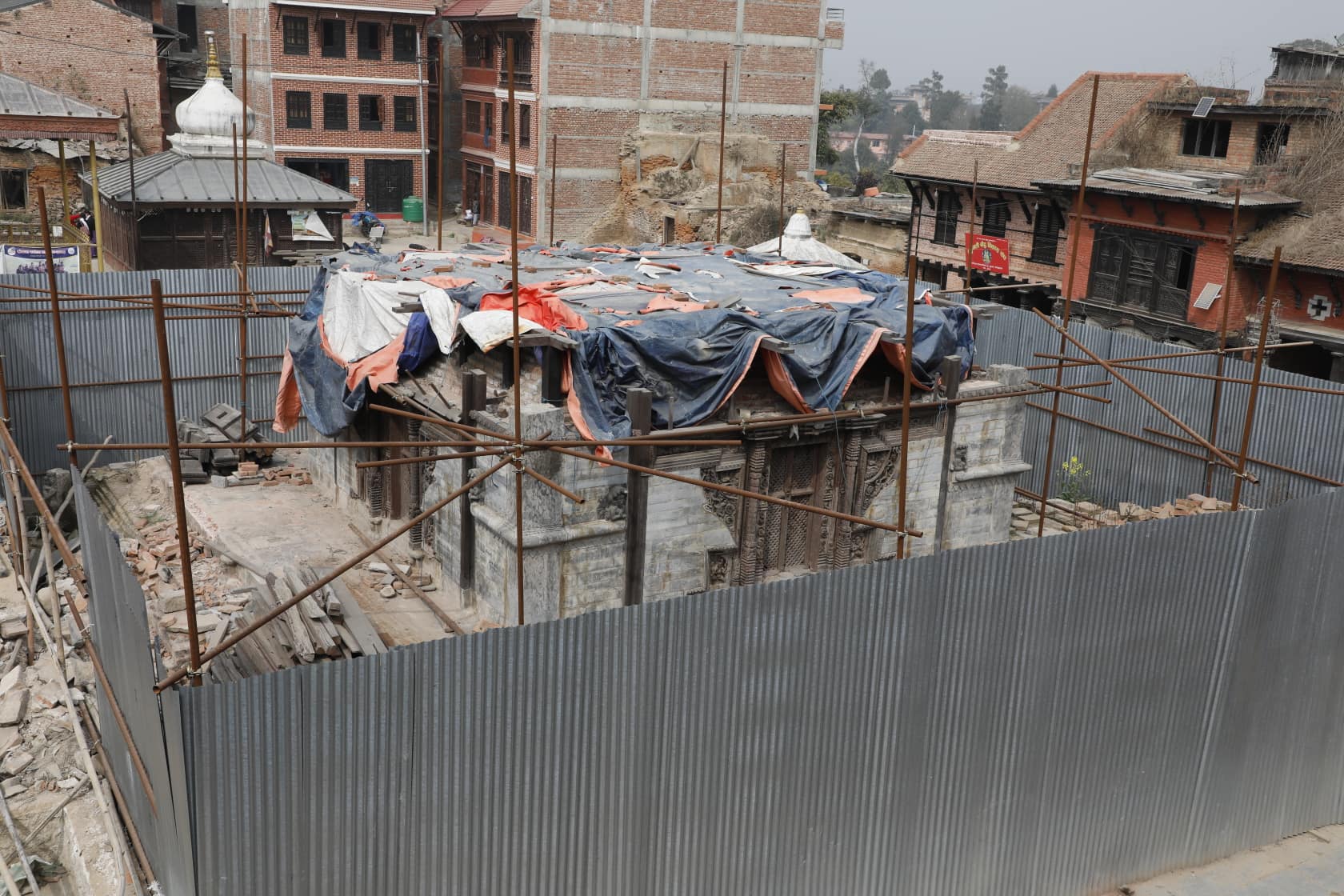
The god of rain, Rato Machhindranath, perhaps would not bless the traditional farmers of Kathmandu Valley with good harvest and prosperity this monsoon also–for his house, the Rato Machhindranath Temple, located in Bungamati of Lalitpur, has not been rebuilt yet. Nearly five years have passed since the 2015 earthquake, but one of the key cultural monuments of the valley is still in rubble.
Recently, the Sri Lankan government has withdrawn from the reconstruction project, pushing the temple’s future further into the limbo. Exploring the reasons for Sri Lanka’s withdrawal, however, exposes that the Sri Lankan move is not the only factor that halted the project. There are multiple controversies that have landed the key reconstruction project into trouble.
Controversy 1: The Sri Lankan withdrawal
The reconstruction was a Rs 52-million project. The Sri Lankan government has already mobilised about Rs 21 million by the end of 2019 when it ‘pulled out’.
The Sri Lankan Embassy’s decision to withdraw from the project has turned controversial as different stakeholders interpret it differently. An official at the Sri Lankan Embassy in Kathmandu refuses to consider the embassy’s decision as a ‘withdrawal’. “In Sri Lanka, the fiscal year ends on December 31. We had sent a verbal note to the Ministry of Foreign Affairs of Nepal on October 14, 2019, seeking concurrence to transfer the remaining money before December 31, 2019. However, we are yet to receive any kind of reply from the Nepali side. Hence, we could not mobilise the money we had earlier pledged for the reconstruction.”

Meanwhile, Kaji Pyakurel, the Museum Officer at National Reconstruction Authority (NRA), comments that the time frame given to the government by the embassy to answer the notice was not long enough and that is why there was no initiation from the Nepali side to claim the allocated money. “On one hand, their fiscal year was ending soon while on the other, it was not possible for Nepal to complete the processing on time as per their request. The Nepal government instead showed a willingness to work on its own.”
It hence seems that the government is willing to reconstruct the temple as soon as possible, but the fund is not available. The concerned officials hope that the government will allocate budget for the project in the next fiscal year. It means it will take months to resume the reconstruction works.
Controversy 2: The ‘competence’ of contractors
After the earthquake, Sri Lanka among many countries had stepped forward to help Nepal rebuild its various structures. In 2016, the Sri Lankan government through its Ministry of Buddha Sasana and Religious Affairs signed a memorandum of understanding with the Nepal government, pledging support in the reconstruction of two sites with historical and cultural importance. The chosen sites were the Anandakuti Mahabihar in Swayambhu of Kathmandu and the Rato Machhindranath Temple in Bungamati of Lalitpur.

The reconstruction works have been completed in the first site, and it awaits the inauguration now. The Bungamati temple, however, has not completed even 50 per cent works.
The Sri Lankan government had called for a tender, in coordination with the Department of Archaeology (DoA), prior to the construction process. Evaluating all the applications through a due procedure, the contract was handed over to three companies jointly. However, the contractors could not convince the stakeholders about their ‘competence’.
The official at the Sri Lankan Embassy reveals that the contractors did not have sufficient expertise and experience in heritage reconstruction. The locals also view that there was ‘negligence’ from the government’s side in selecting the contractors.
The government officials, however, do not agree. Pyakurel at the NRA, who also worked onsite for the project, says that there is no such provision regarding the competence of the contractors in ‘heritage reconstruction’, neither is there any method to assess it. “The contractors had met the requirement of the tender called and that was why they were selected. The claims are not justified; we have to change the act and provisions first.” He, however, admits that the contractors could not perform as efficiently as expected.
Controversy 3: The use of materials

Another controversy that hit the project is about the use of construction materials such as bricks, cement, and limestone. Citing the project used ‘modern’ materials that would affect the temple’s value, the locals had also wanted the project to stop, shares Yagya Ratna Shakya, the chair of the 32-Paneju Sangha, a group of local priests, in Bungamati.
The construction works were initially supposed to finish by June 2018. Yet, even after two extensions, there was no significant progress. The Sri Lankan official now claims that they were not happy with the progress since the beginning.
As of now, preparations are underway to form a user committee to supervise the reconstruction project. Locals say that they are considering many factors to avoid confusions and controversies that arose before, and will form the committee soon “It will comprise of locals, experts, scholars, and local leaders. Along with, an inspection team with representatives from the local ward, the NRA, and the DoA,” says Ambir Raj Shakya, the chair of Lalitpur Metropolitan City-22.
Another Machhindranath temple
The Bungamati-based idol of Rato Machhindranath spends half of every year in Ta:Baha: of core Patan. The idol is carried to Patan from Bungamati a few days before Yomari Punhi and is carried back to Bungamati after Bhoto Dekhaune Jatra. The Ta:Baha: temple, where the idol resides, was also affected by the 2015-earthquake.

The gajur (pinnacle) of the Temple is slightly tilted and it has now been put in place with wires. The locals, including the Guthi Sansthan Lalitpur branch chief Rajan Bhuju, suspect that the temple’s roof has leaked. One of the main priests there, Bhim Ratna Shakya, also shares the concern. However, the problem has not been addressed yet.
Bhuju says the locals have not yet taken any initiative to bring back the temple to its original condition. However, he says the Guthi Sansthan or the local government would soon launch a project in this regard.
Sidhhi Muni Bajracharya, a local priest, says, “The government bodies have the right and duty to maintain and preserve the heritage sites. They are also the ones to enjoy the benefits. Nobody listens to the plea of common people, what is the point in reporting it? Reconstruction in Bungamati is still pending till today; we have no hope anyone would address the issue here before that.”
This shows that the locals do not have a feeling of ownership of the temple.
Meanwhile, on the east of the Machhindranath Temple in Patan and across the street, on the premises of Min Nath Temple, the locals have started reconstruction of a sattal, a place to keep the statues and other things. “After our multiple pleas went unheard, we [the locals] initiated and finished the initial phase of the design. We have now got Rs five million from the provincial government for the reconstruction. We are aiming to mobilise the budget before this fiscal year,” informs Deependra Shakya, a local priest.

The main priest Shakya also puts forward his request that the priest’s residential house also be rebuilt. “After the 2015-earthquake, the house is in support of wooden bars, so the risk of collapse has increased. There is not even a proper lock for rooms where we keep our belongings. The government and concerned authorities have to address this.”







